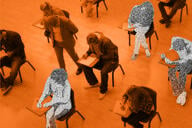You have /5 articles left.
Sign up for a free account or log in.
They’re not just for obnoxious bike messengers anymore. And academe is (slowly) adjusting accordingly.
In the past, nearly all research and teaching on biking – most of which is incorporated into broader transportation courses – has focused on engineering and planning. But, even as more classes of that nature are taking an exclusively bike- and pedestrian-focused approach, a growing number of scholars, many of whom are younger and more plugged in to biking culture, are looking at bicycling through a sociological or anthropological lens.
“It seems like there’s a lot of great work on what sort of infrastructural changes can make a difference, but I think it’s also crucially important to pay attention to what sort of cultural changes should happen if we want to make bicycling an important form of transportation,” said Sarah McCullough, a graduate student at the University of California at Davis who researched how people’s feelings about biking – happy, scared, sad, etc. – relate to their likelihood of actually riding a bike. (She’s finding that people with stronger emotions about biking – and not necessarily just positive ones – are more likely to do it. And people are more likely to bike when they perceive it as safe and socially normal.) “Just understanding how changes in cultural infrastructure have to accompany changes in physical infrastructure; it’s not necessarily enough in many communities just to put in a bike lane. You also have to create a culture where people feel comfortable using it.”
Rebecca Sanders, a University of California at Berkeley doctoral student in city and regional planning who helps teach a course on bicycle and pedestrian (“bike-ped”) transportation and its history, societal implications, planning and design, said that the rise of anthropological bicycle studies is largely being driven by a younger generation – and when the people who are graduate students now become faculty, it might be easier to get these courses institutionalized. (Lees-McRae College, on the other hand, has an entire cycling minor.)
“I do think there is a reluctance to embrace pedestrian and bike transportation among some in the profession as legitimate modes,” Sanders said. “The good news is, I guess, you have a lot of people really interested in these issues. The bad news is, if those people go away, so does the class.”
Of course, Sanders acknowledged, it’s not only the grad students driving – or, rather, riding – the change. Luis Vivanco, director of the Global and Regional Studies Program at the University of Vermont, demonstrates that. An environmental anthropologist, Vivanco has spent the last couple of years doing field research on how people think about bikes and developing courses on the social science of bicycles.
“No one is really talking about the culture of the bicycle and the cultural impacts of bicycles on people’s lives,” said Vivanco, who teaches a course on bicycles, globalization and sustainability. “You do see it around the edges. You see it in cities that are maybe more progressive politically, environmentally conscious. When a city like New York starts getting serious about it, I think New York universities are going to start asking questions.”
Chicago is a good case study, Vivanco said. Part of now-Mayor Rahm Emanuel’s election platform was turning Chicago into a world-class bike city. Why? Chicago has car-clogged streets. There are 650,000 people suffering from asthma and other respiratory illnesses linked to car fuels. The city (like many) has an obesity problem.
“These are all big costs for the city,” Vivanco said. “When I think about, what’s an academic justification [for studying this], it’s more that I’m responding to the way changes in officials are thinking about transportation. They’re starting to shift the conversation so it isn’t always, how do we address cars. It’s more, how do we adjust transportation so we can address all these big social problems that we have.”
Entire courses devoted to biking are still relatively uncommon, and in lots of cases, bike-ped material is part of other transportation-oriented or general policy planning classes, at least a dozen have been identified by the Transportation Research Board’s Joint Subcommittee on Pedestrian and Bicycle University Transportation.
“Some of them are because you get one professor who is really passionate about expanding transportation knowledge,” or perhaps addressing health or the environment, said Bob Schneider, who teaches the Berkeley course with Sanders (the latter also chairs the subcommittee). “But a lot of the time it’s because students really have the fire and are advocating for this class.”
While this sort of work, experts agree, is not totally confined to ultra-progressive liberal havens – one of the top bicycling researchers is in New Jersey, for instance, and courses have emerged in places like Georgia and Louisiana – it does help to be in a city willing to invest in it."invest in it" kind of vague. maybe: "engaged in biking." -sj *** vague if they're literally investing in it? Like, financially? If yes, fine to change. -ag Unsurprisingly, Portland State University in Oregon boasts an entire Initiative for Bicycle and Pedestrian Innovation within its urban studies and planning school.
The city of Portland works with the university to fund research and share data, and the city continues to invest in innovative biking infrastructure. That gives Portland State students, more of whom are writing dissertations on bicycling, plenty of research opportunities as well as a “living laboratory” in which to work, said Jennifer Dill, a professor of urban studies and planning and director of the Oregon Transportation Research and Education Consortium.
“More and more of the research is pointing to the fact that also people’s attitudes, social norms and things like that have an influence over their decisions to bike or walk or take public transit,” Dill said. “We’re trying to expand the disciplines that are looking at bicycle research.”
One study considered potential economic benefits of biking infrastructure by looking at how much people spend at bars and restaurants when they bike vs. drive. Another by a civil engineer researched air pollution cyclists are breathing. (In Portland, installing a cycle track – where the bike lane is moved from the actual street alongside drivers to the other side of a row of parked cars – resulted in bikers breathing less of some pollutants.) A third study equipped more than 150 adult riders with GPS units to analyze their deciding factors in choosing particular routes – so, for instance, a city might consider the extent to which riders avoid hills when deciding where to install its next bike lane.
Dill, who just finished chairing the Transportation Research Board’s Bicycle Transportation Committee, said the volume of papers it received on bicycle research has “at least doubled” in the past six years, and the research is coming from all across the country.
“It’s not the same old group anymore. You’re getting both new faculty who, this is their passion, or you’re getting faculty who maybe had been looking at something else and now are expanding to look at bicycles as well,” Dill said. “It’s an area ripe for research. It’s of growing importance for transportation, particularly in the urban areas, and there just hasn’t been a lot of research on it, so there’s a lot of need, there’s a lot of questions to be answered.”
Dill also teaches a course on bicycle and pedestrian planning, which she said is very popular. Lots of graduate students now are going to Portland State with an interest in that exact topic. And while she’s obviously a proponent of the more focused courses, Dill also said it’s crucial that broader planning classes continue to incorporate bikes.
“The stand-alone bicycle-pedestrian class is a good idea, but that’s only going to go so far, and trying to integrate these ideas into the standard transportation engineering class,” she said, “is really important so you’re reaching a wider range of professionals.”
And there’s still a lot of work to be done, Vivanco, of Vermont, said.
“By American standards, Portland’s way out in front,” he said. “But by European standards?”
Not so much.




